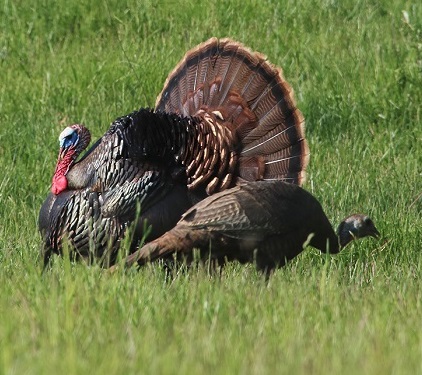 Spring Turkey Season. Those three words make me smile ear to ear. Everything looks so bright and fresh in the early spring. Early spring is when you can finally see through the forest everything is still low to the ground and just starting to get its new fresh green growth.
Spring Turkey Season. Those three words make me smile ear to ear. Everything looks so bright and fresh in the early spring. Early spring is when you can finally see through the forest everything is still low to the ground and just starting to get its new fresh green growth.
We had turkeys moving through our property all winter. We’d see the highway of turkey tracks, the scratching in the beech and maple leaves, and a group of turkeys in our neighbor’s cornfield looking for any kernels left from the fall harvest. Now, with the snow gone and the thick layer of leaves everywhere, I’m having a harder time finding the turkey evidence but am enjoying the challenge.
Here are a few tips to help you prepare for the season.
1. Apply for a Spring Turkey License
Turkeys can be found in every county in Michigan and anyone who wants to hunt a turkey can get a license. Michigan has several turkey seasons for you to choose from. Some you do have to apply for in advance because there are more hunters than turkey licenses available. Anyone can hunt turkeys for most of the month of May, in what’s called Hunt 234. Hunt 234 is a great, flexible option for hunters who may want to hunt in many different places and who want more than 7 days to find those turkeys.
The early seasons, that have a limited number of licenses, are open for a short time, making weather and work schedules a real consideration. Mi-Hunt is a great mapping program that you can use to look for public land in Michigan that is open to hunting. With over 4 million acres of public land available, Mi-Hunt allows you to build your adventure at home from your computer!
2. Find a Place to Hunt
The turkey story in Michigan is truly amazing – our state has made huge strides in wildlife management. Like most states, there was a time when today’s common animals were either gone completely or very hard to find. Wild turkeys were once a rarity in Michigan. It’s hard to imagine, but wildlife didn’t have any protections for a long time. In the late 1800’s grocery stores weren’t on the corner, families were clearing land for settlements and hunting regulations were unheard of. Now, everything has changed.
The Federal Aid in Wildlife Restoration Act (aka the Pittman-Roberson Act of 1937) was enacted. A national coalition of conservationists, backed by the sporting arms and ammunition industry, persuaded Congress to direct an excise tax on those items to a special fund for wildlife restoration. With a lot of hard work and dedication in the 1950s, the turkey population was reestablished.
3. Be Patient and Have Fun!
If you’ve ever thought about giving turkey hunting a try, this is your year! Turkey hunting provides good healthy local protein that you can harvest yourself in a very interactive hunt. You can use a call to sound like a turkey and get one to answer you back!
So when you are crawling on your belly, trying to sneak up on some gobbling toms remember: Only a few decades ago, turkeys were hard to find and only a few people were able to hunt them. Today, everyone has a chance.
About the Author: Katie Keen is a wildlife communications coordinator for the DNR in Cadillac, who spends her working hours with hunters, landowners, educators and media representatives to help with their DNR-related needs. In her spare time, she is a wife and mother who loves to be outdoors and educate folks about the DNR.
Related articles:
Union Sportsmen’s Alliance Spring Turkey Sweepstakes
Ten Tips for a Safe Spring Turkey Hunt
Are You Ready For Spring Turkey Calling … T-Bone’s Turkey Magnet
